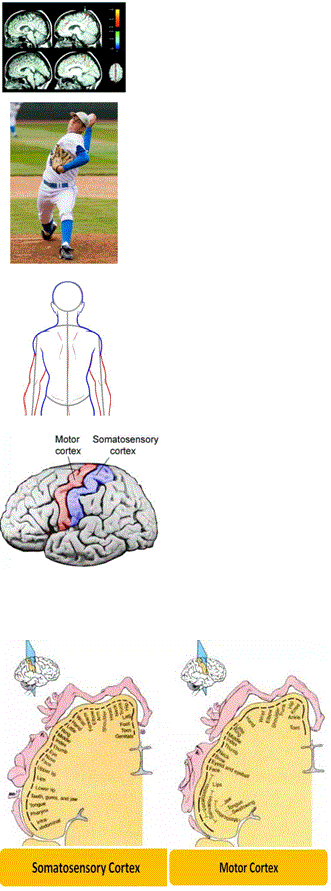Using fMRIs, people with chronic LBP have been shown to have markedly different cortical representation of their back when compared to healthy controls.
Patients with chronic LBP have also been shown to have a disruption of their body schema of their trunks as they have difficulty identifying images involving left versus right trunk rotation.
Is this pitcher turned to the right or left?
To answer the question, you visualized your own body schema doing the action.
Lorimer Moseley, PT, PhD has shown that “body image is disrupted, and tactile acuity is decreased, in the area of usual pain, in patients with chronic back pain.”
For instance, patients with chronic LBP were instructed to complete a drawing of their back. They were instructed “Concentrate on your back, draw the outline of your back as you track it in your mind. Concentrate on where you feel your back to be.
The patients given this task had difficulty completing the simple act of drawing an outline of their backs and reported…
“I can’t find it”
“It feels as though my back has shrunk”
There is now growing evidence that those with LBP also have distorted cortical representation of their lumbar spine. Fascinatingly, one study showed the representation of their back had shifted by about 2cm in the somatosensory cortex.
Before I continue, it must be appreciated that not all patients with LBP develop cortical changes and somatosensory disruption …what we still don’t know is why some do and why some don’t. Researchers are still trying to figure this out. At the same time researchers are trying to link these cortical changes that occur in some to persistent pain.
Why would cortical changes and somatosensory disruptions cause persistent pain? …here is a theory.
We have homunculus representations in the somatosensory cortex and the motor cortex. In the somatosensory cortex the size of the body part representation is directly based on the degree of sensory acuity of the body part. For instance the hands have a larger representation than the entire trunk.
Although closely linked and similar, in the motor cortex the size of the body part representation is based on the motor capabilities of the body part, for instance the mouth and tongue have a larger representation than the entire trunk.
As mentioned before, somatosensory reorganization distorts the cortical body map; however the brain relies on this sensory map to execute movement. This distortion may be causing incompatibility between motor commands and sensory feedback …which may produce pain!
(Side note: This incompatibility with motor commands and sensory feedback may explain phantom limb pain)
These cortical changes may to some degree be a contributing factor to pain maintenance. Perhaps interventions to “normalize” cortical distortions may help the motor commands become once again compatible with the sensory feedback ?and voila: no pain!
Before any of us get too excited, we are still far way from really proving this concept; however as a clinician wanting to help my patients with persistent pain it is a far better model for persistent pain than the current tissue injury model and the chase after the pain with ultrasound gel model.
1. Bray H, Moseley GL. Disrupted working body schema of the trunk in people with back pain. Br J Sports Med. 2011 Mar;45(3):168-73.
2. Moseley GL1. I can’t find it! Distorted body image and tactile dysfunction in patients with chronic back pain Pain. 2008 Nov 15;140(1):239-43
3. Flor H, et alExtensive reorganization of primary somatosensory cortex in chronic back pain patients. Neurosci Lett 1997;224:5?8.
4. Gustin SM, et al: Pain and plasticity: is chronic pain always associated with somatosensory cortex activity and reorganization? J Neurosci 2012, 32(Suppl 43):14874-14884.


